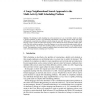Free Online Productivity Tools
i2Speak
i2Symbol
i2OCR
iTex2Img
iWeb2Print
iWeb2Shot
i2Type
iPdf2Split
iPdf2Merge
i2Bopomofo
i2Arabic
i2Style
i2Image
i2PDF
iLatex2Rtf
Sci2ools
HEURISTICS
2010
2010
A large neighbourhood search approach to the multi-activity shift scheduling problem
The challenge in shift scheduling lies in the construction of a set of work shifts, which are subject to specific regulations, in order to cover fluctuating staff demands. This problem becomes harder when multiskill employees can perform many different activities during the same shift. In this paper, we show how formal languages (such as regular and context-free languages) can be enhanced and used to model the complex regulations of the shift construction problem. From these languages we can derive specialized graph structures that can be searched efficiently. The overall shift scheduling problem can then be solved using a Large Neighbourhood Search. These approaches are able to return near optimal solution on traditional single activity problems and they scale well on large instances containing up to 10 activities.
| Added | 17 May 2011 |
| Updated | 17 May 2011 |
| Type | Journal |
| Year | 2010 |
| Where | HEURISTICS |
| Authors | Claude-Guy Quimper, Louis-Martin Rousseau |
Comments (0)

